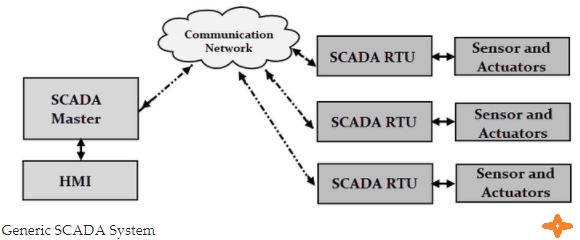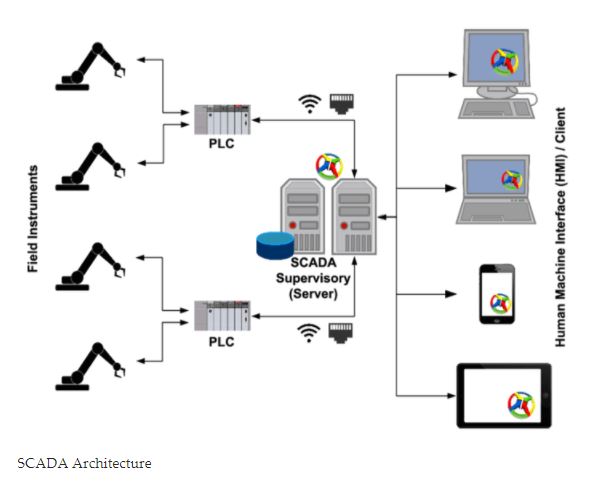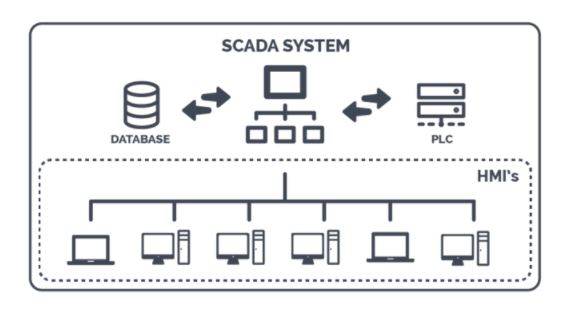A SCADA stand for (Supervisory control and data acquisition) is a control system architecture comprising computers, networked data communications and graphical user interfaces (GUI) for high-level process supervisory management, while also comprising other peripheral devices like programmable logic controllers (PLC) and discrete proportional-integral-derivative (PID) controllers to interface with process plant or machinery.
What is SCADA
SCADA is a type of process control system architecture that uses computers, networked data communications and graphical Human Machine Interfaces (HMIs) to enable a high-level process supervisory management and control.
SCADA systems communicate with other devices such as programmable logic controllers (PLCs) and PID controllers to interact with industrial process plant and equipment. SCADA systems form a large part of control systems engineering. SCADA systems gather pieces of information and data from a process that is analysed in real-time (the “DA” in SCADA). It records and logs the data, as well as representing the collected data on various HMIs.

This enables process control operators to supervise (the “S” in SCADA) what is going on in the field, even from a distant location. It also enables operators to control (the “C” in SCADA) these processes by interacting with the HMI.SCADA systems are essential to a wide range of industries and are broadly used for the controlling and monitoring of a process. SCADA systems are prominently used as they have the power to control, monitor, and transmit data in a smart and seamless way. In today’s data-driven world, we are always looking for ways to increase automation and make smarter decisions through the proper use of data – and SCADA systems are a great way of achieving this.
SCADA systems can be run virtually, which allows the operator to keep a track of the entire process from his place or control room. Time can be saved by using SCADA efficiently. One such excellent example is, SCADA systems are used extensively in the Oil and Gas sector. Large pipelines will be used to transfer oil and chemicals inside the manufacturing unit.
SCADA Architecture

Generic SCADA systems contain both hardware and software components. The computer used for analysis should be loaded with SCADA software. The hardware component receives the input data and feds it into the system for further analysis.
SCADA system contains a hard disk, which records and stores the data into a file, after which it is printed as when needed by the human operator. SCADA systems are used in various industries and manufacturing units like Energy, Food and Beverage, Oil and Gas, Power, Water, and Waste Management units and many more.
History of SCADA
Earlier to the birth of SCADA, manufacturing floors and industrial plants relied on the manual control and monitor using push buttons and analog equipment. As the size of the industries and manufacturing units grew in size, they started using relays and timers, that provided supervisory control to a certain extent.
Unfortunately, relays and timers were able to solve problems only with minimal automation functionality and reconfiguring the system was difficult. So, a more efficient and fully automated system was required by all industries.
Computers were developed for industrial control purposes in the early 1950s. Slowly, the telemetry concept was introduced for virtual communication and transmission of data. Around the year 1970, the term SCADA was coined along with the evolution of Microprocessors and PLC concepts. So, this helped for the development of a fully automated system, that can be used remotely in Industry. As years rolled by, in the early 2000s, distributed SCADA systems were developed.
Modern SCADA systems came into existence that allowed us to control and monitor real-time data anywhere in the world. The real-time interaction boomed up the business and took the growth of industries to greater heights. Even if the operator did not have much knowledge of software development, he was able to manage the modern SCADA systems.
Basics of SCADA
Objectives of SCADA
- Monitor: SCADA systems continuously monitor the physical parameters
- Measure: It measures the parameter for processing
- Data Acquisition: It acquires data from RTU, data loggers, etc
- Data Communication: It helps to communicate and transmit a large amount of data between MTU and RTU units
- Controlling: Online real-time monitoring and controlling of the process
- Automation: It helps for automatic transmission and functionality
The SCADA systems consist of hardware units and software units. SCADA applications are run using a server. Desktop computers and screens act as an HMI which are connected to the server. The major components of a SCADA system include:
- Master Terminal Unit (MTU)
- Remote Terminal Unit (RTU)
- Communication Network (defined by its network topology)

Master Terminal Unit (MTU)
MTU is the core of the SCADA system. It comprises a computer, PLC and a network server that helps MTU to communicate with the RTUs. MTU begins communication, collects and saves data, helps to interface with operators and to communicate data to other systems.
Remote Terminal Unit (RTU)
Being employed in the field sites, each Remote Terminal Unit (RTU) is connected with sensors and actuators. RTU is used to collect information from these sensors and further sends the data to MTU. RTUs have the storage capacity facility. So, it stores the data and transmits the data when MTU sends the corresponding command. Recently developed units are employed with sophisticated systems, that utilize PLCs as RTUs. This helps for direct transfer and control of data without any signal from MTU.

Communication Network
In general, network means connection. When you tell a communication network, it is defined as a link between RTU in the field to MTU in the central location. The bidirectional wired or wireless communication channel is used for networking purposes. Various other communication mediums like fiber optic cables, twisted pair cables, etc. are also used.
Functions of SCADA Systems
In a nutshell, we can tell the SCADA system is a collection of hardware and software components that allows the manufacturing units to perform specific functions. Some of the important functions include
- To monitor and gather data in real-time
- To interact with field devices and control stations via Human Machine Interface (HMI)
- To record systems events into a log file
- To control manufacturing process virtually
- Information Storage and Reports
SCADA Software
As discussed earlier, SCADA software plays a significant role in the whole process analysis. There are several big manufacturing companies that work exclusively on SCADA software. There are many factors to be looked upon before the SCADA software is selected and implemented. To mention a few,
- The lifespan of the Software: Since you are going to invest a lot in procuring the software, it is always better to check if the software would last between 5 to 10 years down the lane.
- Request for Information: It is a business term used to specify details about vendors and suppliers. If you buy software from a particular vendor, he/she should be able to give you technical support whenever required.
- Historian Software: The term historian means, the software should save data with timestamps, that can be used for future reference. So, your software should be proficient of handling the data from the field and logging the same.
- SCADA technology: As we all know, technology is growing rapidly so as to meet our needs. When you mean technology, it does not imply that always you need to use the latest technology that pops up in the market. Rather, you should choose a technology that can stay stable and secure for a longer time.
- Alarm Supervision and Management: Almost all SCADA systems have an alarming feature that comes along with software development. Configuration of alarm is important. There are two types of alarm system namely system defined alarm managed by the system by itself and user-defined alarm which is managed by the user.
Let us have a look into software developed by big players in the market.
Citect SCADA – Schneider Electric
A compact, flexible and reliable SCADA software developed by Schneider Electric. The latest product released by them is Vijeo Citect (version7.10) Citect SCADA is still one of the commonly used SCADA technologies and you certainly need to learn about this platform as a SCADA developer. It has actually become part of the SCADA alternatives for Wonderware.
InTouch – Wonderware
InTouch, which has become one of the largest SCADA suppliers on the market, comes from Wonderware, now owned by Schneider Electric. Although Wonderware is relatively new to the market, it is quickly gaining popularity.
The Wonderware system platform is a SCADA system with many “plug-and-play” parts that is modular and very versatile. Because of the modularity of this scheme, you can readily customize it to your requirements if you choose this SCADA software. The benefit of In Touch is that they use open standards of communication and can operate with most PLC systems.
Experion SCADA – Honeywell
Honeywell is commonly used in PLC systems (particularly in the US). They are also a big player in the SCADA market, providing a software platform for programming SCADA and HMI systems. You can either use their software for a stand-alone SCADA scheme or use it with Honeywell’s PLC platform (e.g. C200 and C300 platform) as well as RTU’s like Control Edge RTU.
Although Honeywell’s SCADA software works are optimized to communicate with other Honeywell products (e.g. PLCs and RTUs), it will still work when paired with non-Honeywell products.
iFIX – General Electric
General Electric (GE) is one of the world’s largest manufacturing businesses, is also a significant player in the SCADA market. IFIX is one of their software solutions and it is a very flexible SCADA system. The advantage of using iFIX is its ability to develop screens quickly with HTML5.
Another reason is the many drivers that allow you to set up networked and distributed systems, allowing you to connect and exchange information with most contemporary PLCs. GE also have their own branded PLCs – but a GE SCADA system does not require these GE PLCs to function correctly.
Ignition – Inductive Automation
Ignition is a SCADA scheme that uses the latest IoT architecture to its full potential. Ignition from Induction Automation is a very nice option if you want a system that is up-to-date with all Industry 4.0 norms and techniques. Ignition is relatively new to the SCADA industry compared to some of the veteran systems. That said between Ignition’s IoT integrations and the fact that they work with most PLC systems, Ignition has been chosen by many businesses as their SCADA solution.
SIMATIC WinCC V7 – Siemens
The Siemens SCADA system has been around for many years, and is known as “WinCC”. Siemens is one of the largest players in the PLC and SCADA industry, and many businesses use the Siemens platform. Siemens is a huge company that has been evolving their PLC and SCADA platforms over the years to adopt modern technologies. The fact that they are a large and veteran player in the SCADA industry gives many businesses confidence in entrusting them with their SCADA applications.
Applications
- SCADA has made comprehensive use of features such as flexibility, reliability, and scalability in automating complex systems.
- There are countless applications in the real world where SCADA has already been effective in providing surveillance and control alternatives across a broad spectrum of sectors, from energy production to agricultural systems.
- SCADA is widely used in different areas from chemical, gas, water, communications and power systems
Electric Power Generation, Transmission, and Distribution
Using SCADA systems, electrical utilities detect current flow and line voltage, monitor circuit breaker operation, and take sections of the power grid online or offline.
Manufacturing Units
SCADA systems are used to regulate industrial automation and robots, and monitor process and quality control
Mass transit and Railway Traction
Transit officials use SCADA to regulate electricity for subways, trams and trolley busses; to automate railway traffic signals; to monitor and identify trains and busses, and to control railway crossing doors
Water, Waste Water Utilities and Sewage
State and municipal water utilities use SCADA to monitor and control water flow, tank concentrations, pipe pressure, and other variables

Buildings, Facilities, and Environments
Facility managers use SCADA to regulate HVAC, cooling, lighting and input systems.
Water Security: The Role of the SCADA System
A lot of research continues to be performed on how to implement modern SCADA concepts into water treatment plants whilst minimizing the risk of unauthorized network access (cyber risk is an ongoing issue in large enterprises). The communication network of SCADA is distributed across the water distribution system as shown in the figure below. Workstations, typically PC-based are situated at a treatment facility in a control room, enable operators to view the entire process and take control measures.

Within the plant, PLCs are used in chemical treatment and filters. Local Area Network (LAN) is utilized to link the controllers to workstations. Remote terminal units (RTUs) are used in remote locations and are generally found in sensitive fields such as pump stations, storage tanks, valve vaults, and treatment centers.
The RTU communicates on a wide area network typified by the radio scheme shown in the following figure. A significant benefit of SCADA schemes is the coordination of safety measures with activities. A SCADA system connected to perimeter surveillance systems can either decrease the need for manned patrols considerably or eliminate them.The SCADA scheme can provide ongoing surveillance of all places, unlike patrols. You can easily interface security systems or appliances, including video cameras, motion detectors, contact switches, keypad entry devices, and card readers, either directly to the SCADA network or via a neighboring remote terminal unit (RTU). Today’s SCADA systems also give alarm management in instances where many alarms happen in a brief moment.
Thermal Power Plants
Most operational inspections of thermal power plants are automatic. However, manual action may be necessary at times. The plant is therefore equipped with monitoring and alarm systems that alert plant operators when certain working para counter deviates significantly from their normal range.
The demand for greater reliability and effectiveness is growing in thermal power plants. After periodic intervals, the power plant needs continuous inspection and tracking. There may be chances of mistakes when human employees measure at different phases.
To improve reliability, automation is required to improve the general power plant efficiency. Automation is established through the use of PLC & SCADA, which decreases human workers’ mistakes. SCADA system is used to supervise a complete process
Forestry, Pulp and Paper Industry
The forestry, pulp and paper industry also relies on SCADA systems. From automation & process control, energy management, drive control, power protection, enclosure systems, and safety – the industry has ample uses for SCADA.
SCADA systems are used throughout the paper supply chain – including within the wood yard, to the chippers, evaporators, digestors, refiners, cleaners, drying & pressing, and of course the paper machines. This complex processing of trees to paper is automated from end-to-end through the use of established SCADA systems.
Difference Between PLC and SCADA
SCADA and PLCs can easily be confused when you’re first learning about control engineering. You will often hear the terms “PLC” and “SCADA” used within the same breath. Although they are related, they are distinctly different from one another.
| PLC | SCADA |
| A PLC is a “Programmable Logic Controller”. This is essentially a ruggedized mini-computer that sits out in the field within a panel, with a bunch of inputs and outputs leading from devices in the field into the PLC. The PLC will monitor the state of these inputs (e.g. the speed of a motor) and depending on the program inside, programmatically output various signals to control these field devices (e.g. stop the motor). | SCADA systems sit “on top” of PLCs. PLCs are almost always part of a SCADA network and form an interface between the field and SCADA. The data that is logged and stored in a SCADA system is typically acquired through communication with the PLC. The PLC will continue to execute its program, reading inputs and writing outputs. |
| The SCADA system is used to keep a log of the historical state of these inputs and outputs, which can be used for data analysis or auditing. PLCs have limited capacity for long-term data storage. | Although SCADA systems can be programmed to control certain aspects of the field – this is usually an unwanted situation. Ideally, your PLC would run autonomously, able to programmatically handle any situation it encounters. Due to the complexity of the real world, this is often not the case. In these cases, operator input is required for the correct functioning of these semi-autonomous systems. |
| Hence the level of “control” to the SCADA screen (i.e. HMI) that the operator interacts with is generally much less than the control executed by a PLC. Anything that can be easily programmed into logic (e.g. IF the flow rate exceeds 100 meters/second, STOP the pump) will be programmed into the PLC. | So SCADA systems are primarily used for monitoring and data acquisition, with control capabilities used under irregular or complex circumstances. SCADA allows operators (and control systems engineers) to see an overview of the plant from a distance, giving them the ability to respond to any abnormal states. It should be noted that a SCADA system technically includes PLCs, which SCADA will communicate with. |